An Overview of Asbestos Fibre
Introduction Asbestos is known to heavy toxicity. The inhalation of this toxic fibre can cause serious illness, including malignant mesothelioma, asbestosis, and lung cancer (also called pneumoconiosis). Since the mid 1980s, many uses of this fibre have been banned in several countries. This fibre became increasingly popular among manufacturers and builders in the late 19th century[…]






